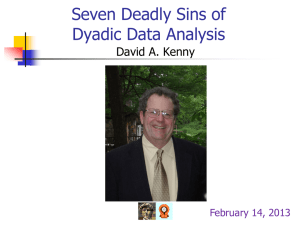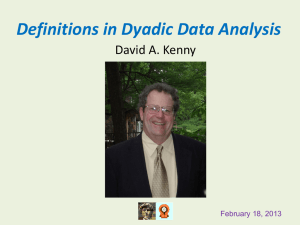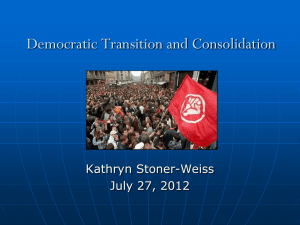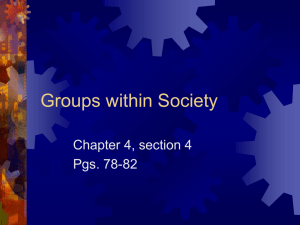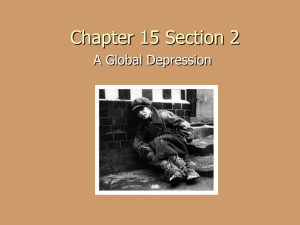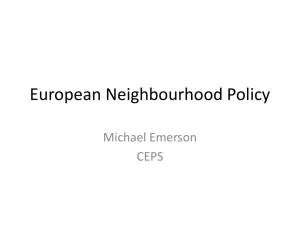Supplementary Appendix
advertisement
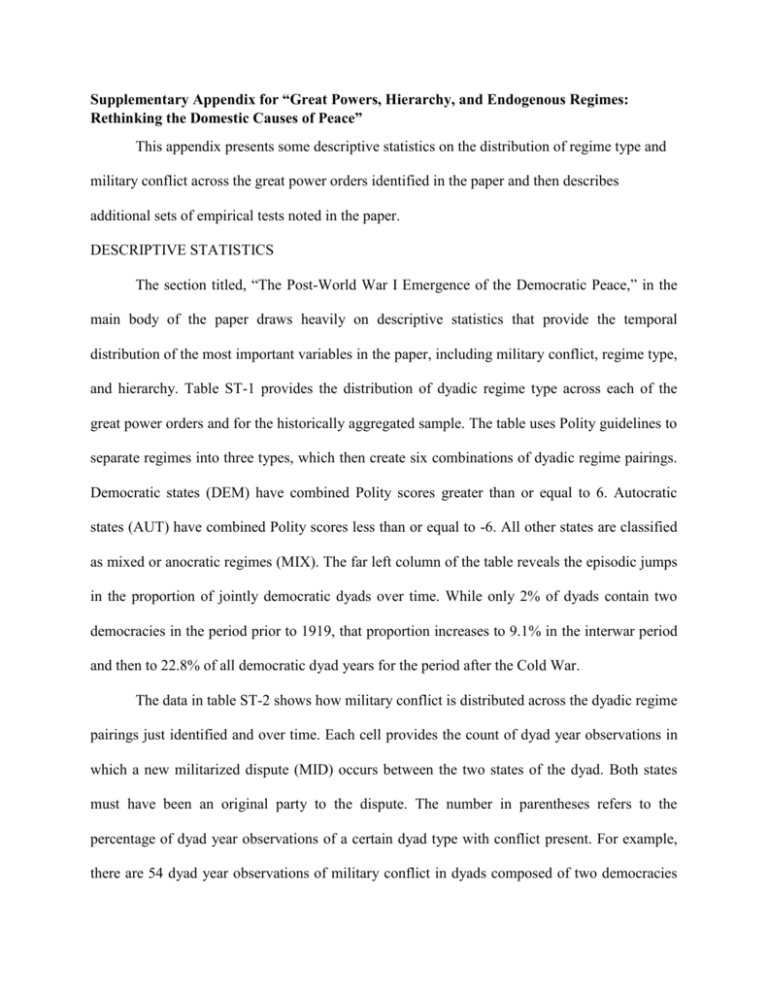
Supplementary Appendix for “Great Powers, Hierarchy, and Endogenous Regimes: Rethinking the Domestic Causes of Peace” This appendix presents some descriptive statistics on the distribution of regime type and military conflict across the great power orders identified in the paper and then describes additional sets of empirical tests noted in the paper. DESCRIPTIVE STATISTICS The section titled, “The Post-World War I Emergence of the Democratic Peace,” in the main body of the paper draws heavily on descriptive statistics that provide the temporal distribution of the most important variables in the paper, including military conflict, regime type, and hierarchy. Table ST-1 provides the distribution of dyadic regime type across each of the great power orders and for the historically aggregated sample. The table uses Polity guidelines to separate regimes into three types, which then create six combinations of dyadic regime pairings. Democratic states (DEM) have combined Polity scores greater than or equal to 6. Autocratic states (AUT) have combined Polity scores less than or equal to -6. All other states are classified as mixed or anocratic regimes (MIX). The far left column of the table reveals the episodic jumps in the proportion of jointly democratic dyads over time. While only 2% of dyads contain two democracies in the period prior to 1919, that proportion increases to 9.1% in the interwar period and then to 22.8% of all democratic dyad years for the period after the Cold War. The data in table ST-2 shows how military conflict is distributed across the dyadic regime pairings just identified and over time. Each cell provides the count of dyad year observations in which a new militarized dispute (MID) occurs between the two states of the dyad. Both states must have been an original party to the dispute. The number in parentheses refers to the percentage of dyad year observations of a certain dyad type with conflict present. For example, there are 54 dyad year observations of military conflict in dyads composed of two democracies during the Cold War. This constitutes 0.20% of all dyad year observations with two democracies for that period (26,366). One of the important historical contradictions motivating this paper can be seen in the upper left box of Table ST-2. Across each of the great power orders, the most conflict prone regime pairing is that made up of two democracies in the period before World War I. The data in ST-3 show how democracy and hierarchy are jointly distributed in the baseline regression sample. The most important post-World War I change can be seen in the last row of the table. One state was allied to a great power in only 5.6% of all democratic dyads in the period prior to 1919. This proportion skyrockets to 70.6% of all democratic dyads after World War I. As noted in the paper, this is an important neglected historical change//--//namely the extension of some form of a security commitment by great powers to democracies//--//that helps to account for the emergence of the democratic peace after World War I. The entries in ST-4 show provide more information about the group of democratic dyad year observations (55,740) in the post-World War I sample. As noted in the paper, approximately 85% of these observations are connected to the larger structure of great power politics in two ways. At least one member of the dyad is either allied to a great power or became democratic in the aftermath of either World War I or the Cold War. These numbers should be compared to the data in ST-1. For example, there are 4,169 democratic dyad year observations. As the paper notes, 73% (3,062) of them include at least one state that democratized after World War I. This proportion is slightly lower in ST-4 (2,428 of 4,169) because it only includes “new” democratic dyads in which neither state is allied to a great power. This table is designed to illustrate the costs of treating regime type as exogenous in the sample. A significant proportion of democratic dyad 1 year observations have some important connection to the larger structure of great power politics either through a hierarchical relationship or systemically induced wave of democratization. ADDITIONAL STATISTICAL MODELS The inclusion of joiners in the operationalization of military conflict The discussion of hierarchy in the paper argued that the role of originators and joiners in military conflict needs to be separated for an important theoretical reason. Subordinate states in a hierarchical order often join military disputes as part of some obligation to their great power protector. Given conflict patterns during the Cold War (i.e. lots of democratic states joining the United States in a war against an autocratic state), this tendency can inflate observations of military conflict in a way that strengthens the statistical relationship between democracy and peace. However, this coding decision can effectively misattribute the effects of hierarchy to democracy instead. Consequently, the paper described two models run on the Cold War sample in which the operationalization of military conflict included both joiners and originators. These models demonstrated how the standard democratic peace results depends critically on the inclusion of the joining states. Table ST-5 presents the coefficient estimates for the democracy variable in these two models. The results for the full models are available in the replication files. Two stage results This empirical strategy utilizes covariates of democracy to predict its level in the first stage of a set of regression models. It then inserts those predicted values of dyadic democracy in place of the observed values in a second stage model that uses conflict as the dependent variable. Such an approach examines whether factors that shape the emergence of democracy also shape its effect on military conflict. The lower Polity score of the states in the dyad (DEMOCRACY L) serves as the dependent variable in the first stage of the model and military conflict (FATAL 2 MID) is the dependent variable in the second stage. Given my focus on accounting for the apparent the correlation between democracy and peace after World War I, I restrict the sample from 1919 to 2000. The setup for this estimation requires a few important changes from the baseline models. Because I expect that great powers promote domestic institutional similarity within their hierarchical orders, I distinguish hierarchical orders on the basis of whether or not they are led by a democratic or autocratic great power. DEMGPALLY takes on a value of one if either member of a dyad possesses a defensive alliance with a great power whose Polity score is greater than or equal to six. AUTGPALLY takes on a value of one if either member of a dyad possesses a defensive alliance with a great power whose Polity score is less than six. The setup for the second (conflict) stage of the model follows that of the baseline single equation model with two exceptions. First, as noted already, observed values for DEMOCRACYL are replaced with predicted values from a first stage estimation that relies on a model specification similar to recent contributions to the democratization literature that highlight the role of diffusion in regime transitions.1 Second, it also includes the diffusion variables on the right-hand side of the conflict equation.2 The setup of this two-stage statistical model is complicated slightly because democracy is a monadic or state-level attribute while the outbreak of conflict is a dyadic characteristic. Consequently, the right-hand side variables in the assignment or first stage equation are state level attributes, like membership in a great power hierarchy, for the state in the dyad possessing 1 Gleditsch and Ward 2006. The arguments of Gleditsch 2002 linking regional democracy levels to peace suggest that the deletion of these diffusion variables from the second estimating stage to satisfy the exclusion restriction would have been theoretically inappropriate. 2 3 the lower democracy score.3 For example, imagine the dyad between Belgium and Syria in 1975. Because Syria is the least democratic member of the dyad, I utilize its national attributes in 1975 to predict DEMOCRACYL for the dyad in 1975. In the first stage of the model, regime score is modeled as function of six independent variables that capture whether the state (with the lower Polity score) is a member of great power hierarchy led by a democratic state (DEMGPALLYDEML), is a member of a great power hierarchy led by an autocratic state (AUTGPALLYDEML), whether a new military conflict broke out between the dyad members in the year (FATAL MID), energy consumption to proxy for income levels (ENERGYDEML), and two diffusion variables. Drawn from Gleditsch and Ward, NEIGHDEMDEML measures the proportion of democratic states in the neighborhood (within 500 kilometers) of the state with the lowest regime score in the dyad. 4 In the 1975 Syria-Belgium example just mentioned, I would utilize Syria’s neighborhood to measure the proportion of democratic regimes of all states within 500 kilometers of it. GLOBDEM measures the proportion of democratic states relative to all states that are members of the international system in a given year.5 This transition between monadic and dyadic research designs helps to create natural instruments for dyadic democracy by providing multiple variables that should be uncorrelated with the error term in the war equation while still being correlated with DEMOCRACYL. This can be seen by returning to the Syria-Belgium example in 1975. Belgium’s participation in NATO 3 For a similar setup that explores the reciprocal relationship between democracy and peace see Reuveny and Li (2003). When the democracy score for the two members of the dyad is equal, I randomly chose between state A and state B to determine which dyad member’s monadic characteristics would be utilized to predict DEMOCRACYL. 4 Gleditsch and Ward 2006. 5 Recent studies (e.g. Gleditsch and Ward 2006, Brinks and Coppedge 2006) highlight the critical role played by diffusion variables in accounting for a disproportionate amount of variance in democratic transitions. Consequently, their inclusion here stands as the best device to solve the problem of “weak instrument” that occurs when the correlation between an instrument and the treatment variable is low. Weak instruments create inconsistent estimates. For a recent presentation of some guidelines in presenting and evaluating research utilizing instrument variable estimation see Sovey and Green (2011). 4 leads to it being coded as within the American hierarchical sphere of influence. While my discussion of hierarchy argues that this membership should help to prevent conflict within the dyad, I can think of no theoretical reason to expect that Belgium’s alliance with the United States should be related to regime type in Syria. Because Syria possesses the lower regime score, its monadic attributes//--//rather than those of Belgium//--//show up on the right-hand side of the first stage model predicting DEMOCRACYL for that observation. Thus DEMGPALLYDEML would take on a value of zero in the first stage of the equation for this dyad in 1975 (indicating that Syria does not possess a defensive alliance with the democratic great powers in 1975 i.e. the United States, France, and the United Kingdom) while DEMGPALLY would take on a value of one in the second stage of the model (because Belgium is allied with the United States).6 Moreover, all of the variables except GLOBDEM and FATALMID in the first stage of the model predicting regime type will take on this switching characteristic. In sum, the transition between monadic and dyadic attributes creates four potential instruments and increases confidence that any results will not be plagued by problems of inconsistency. The results of this IV approach can be seen in supplementary table 6 (ST-6). There are two columns of results for this model//--//one on the left for the estimation of DEMOCRACYL and one on the right when the dependent variable is military conflict. The diffusion variables behave as expected. As the proportion of neighboring democracies increases, a state’s regime score increases as well. Similarly, the global proportion of democracies is positively related to the lower regime score in the democracy. More importantly for my purposes here, membership in great power hierarchy appears to have a strong effect on regime type. States within great 6 The subscript (DEML) alongside the dummy variable for membership in a hierarchy led by a democratic great power appears in the first stage of the estimation. The absence of a subscript on the hierarchy term refers to that variable in the second stage of the equation. 5 power hierarchies led by democratic states are more likely to be democratic. Similarly, states within great power hierarchies led by autocracies have lower democracy scores.7 The second column contains the coefficient estimates for the conflict equation. They indicate that the twin tendency of hierarchy to shape regime type and peace alters the dyadic relationship between democracy and peace. While the coefficient on the DEMGPALLY variable is negative and statistically significant, the coefficient on AUTGPALLY is not statistically significant. This suggests that a hierarchical peace appears to be restricted to those orders led by democratic great powers like the United States. Moreover, the coefficient on DEMOCRACYL is positive and statistically insignificant. This finding supports the larger contention of this paper, namely that the robust empirical relationship between democracy and peace collapses once the consequences of great power politics and hierarchy on both regime type and peace are explicitly modeled. ALTERING THE CODING OF DEMOCRACY I also examined whether my empirical conclusions rested on how dyadic democracy was measured. Using the regime classification presented in Tables ST-1 and ST-2 of the supplementary appendix, these statistical tests substitute a series of regime dummy variables for the traditional weak-link specification. I constructed six dummy variables that correspond to all the potential pairings of these three regime types--a democracy (D) if the combined Polity score was 6 or greater; an anocracy/mixed regime (M) for combined Polity scores less than 6 and 7 Some caution is in order here when interpreting the standard errors in the first stage. Even though it utilizes monadic attributes to predict the regime score of one state in the dyad, the unit of observation is still the dyad year. Consequently, modeling a monadic attribute in a dyadic research design artificially inflates the number of observations and surely underestimates the standard errors. However, I ran a series of single equation estimates with the same specification when regime type is the endogenous variable (results not shown). The size of the coefficient on DEMGPALLY was similar and statistically significant (p<0.001). The negative relationship between AUTGPALLY and regime type got larger in the post-World War I sample and remained statistically significant (p<0.001). 6 greater than -6; or an autocracy (A) for Polity scores less than or equal to -6. These six regime pairings include dyads composed of two democracies (DD), one democracy and one mixed regime (DM), one democracy and one autocracy (DA), two mixed regimes (MM), one mixed regime and one autocracy (MA), and two autocracies (AA). I then ran regressions with all of these regime pairings except that for joint democracy. Its exclusion allows me to treat it as the reference category and then compare the conflict propensity of jointly democratic dyads relative to all other regime types. The democratic peace hypothesis holds that democratic dyads should be less likely to engage in military conflict than all other regime pairings i.e. the coefficients on all other regime pairing variables should be positive and significant. This specification has two additional virtues. First, the inclusion of just a dummy variable for joint democracy collapses the remaining five groups of regimes together and potentially throws out an important source of variation (relative to joint democracy) among them. The risks associated with the lumping together all nondemocratic regimes can be seen in Weeks (2012). She finds significant differences among autocracies in their willingness to initiate military conflict. Civilian autocratic regimes with powerful societal groups are just as likely to initiate military disputes as democracies. Second, under the weak-link specification, it is theoretically possible to generate a negative and statistically significant coefficient if just one regime pairing (say those composed of one democracy and one autocracy) separate from the others by engaging in lots of military conflict. In this situation, a joint democracy dummy variable could still be significant even without possessing any difference in conflict propensity with some of the remaining regime pairing types. 7 The statistical results using these dyadic regime dummy variables can be seen in supplementary table 7 (ST-7). For space reasons, I suppress presentation of all control variables. This table presents six models that are broken up by great power order in the post-World War I period and by how military conflict is operationalized. The results tell a similar story as that generated with the weak-link specification. The democratic peace holds in each of the three great power orders after World War I if all MIDs are included in the coding of military conflict. However, multiple dyadic pairings (MM, MA, and AA) are not significant in the Cold War order with the country exclusions (i.e. Germany, France, and United Kingdom) discussed in the main body of the paper (results not shown). When the dependent variable includes only fatal disputes, the results are even less robust than with a weak-link specification. Coefficient estimates cannot be generated for the 1919-45 period because there are not any fatal disputes in jointly democratic dyads. For the Cold War period, the coefficients on the dummy variables for (MM) dyads, (MA) dyads, and (AA) dyads fail to achieve statistical significance. In the post-Cold War period, the coefficients on (DM) and (AA) dyads fail to achieve statistical significance. In short, the empirical relationship between democracy and peace breaks down in both the Cold War and post-Cold War periods, again illustrating that it is not as robust as the conventional wisdom suggests. 8 Table ST-1: Distribution of dyadic regime composition across great power orders N DemDem Dem-Mix Mix-Mix Dem-Aut Mix-Aut Aut-Aut 18161918 56,925 1,157 9,279 16,165 4,314 18,295 7,715 (2.0%) (16.3%) (28.4%) (7.6%) (32.1%) (13.6%) 19191945 46,000 4,169 11,501 7,536 7,702 10,726 4,366 (9.1%) (25.0%) (16.4%) (16.7%) (23.3%) (9.5%) 19461991 311,489 26,366 35,188 12,404 93,980 59,069 84,482 (8.5%) (11.3%) (4.0%) (30.2%) (19.0%) (27.1%) 19922000 110,700 25,205 29,942 8,625 23,552 15,033 6,343 (22.8%) (27.1%) (7.8%) (23.1%) (13.6%) (5.7%) Total 525,114 56,897 85,910 44,730 131,548 103,123 102,296 (10.8%) (16.4%) (8.5%) (25.1%) (19.6%) (19.6%) Notes: Each cell entry shows number of observations for each type of dyadic regime pairing by great power order. Sample size is generated by the data restrictions for the right-hand side variables in the baseline regression specification. Number in parenthesis is the proportion of total observation in that great power order comprised by each type of dyadic regime pairing. Table ST-2: Distribution of military conflict across great power order and dyadic regime type 1816-1918 1919-1945 Dem-Dem Dem-Mix Mix-Mix Dem-Aut Mix-Aut Aut-Aut 18 140 145 59 110 47 (1.56%) (1.51%) (0.90%) (1.37%) (0.60%) (0.61%) 15 43 76 56 78 66 9 1946-1991 1992-2000 Total (0.36%) (0.37%) (1.01%) (0.73%) (0.73%) (1.51%) 54 133 39 447 181 275 (0.20%) (0.38%) (0.31%) (0.48%) (0.31%) (0.33%) 49 67 33 88 59 36 (0.19%) (0.22%) (0.38%) (0.34%) (0.39%) (0.57%) 136 383 293 650 428 424 (0.24%) (0.45%) (0.66%) (0.49%) (0.42%) (0.57%) Notes: Each entry is the number of conflict observations for a given dyadic regime pairing in a given great power order. Number in parentheses is that count divided by the number of observations for that regime pairing in a given great power order e.g. a new dispute broke out in 1.56% of all observations for dyads composed of two democracies in the period from 1816 to 1918. Counts are drawn from the sample generated by the baseline model specification. Table ST-3: Sample distribution of democracy and hierarchy before and after World War I 1816-1918 56,925 1919-2000 468,054 1816-2000 525,114 1,157 (2.0%) 55,740 (11.9%) 56,897 (11.0%) 12,523 (22.0%) 249,802 (53.4%) 262,325 (50.0%) DEM GP ALLY 1,618 (2.8%) 214,571 (45.8%) 216,189 (41.2%) AUT GP ALLY 10,905 (19.2%) 35,231 (7.5%) 46,136 (8.8%) 5.6% (65 of 1,157) 70.6% (39,263 of 55,740) 69.1% (39,328 of 56,897) Dyadic observations Democratic-Democratic dyads GP ALLY % of Democratic-Democratic dyads with GP ALLY 10 For all cells except those in the bottom row, the number in parentheses is percentage of cases relative to total dyadic observations listed in the top row of that column. Table ST-4: Distribution of dyads composed of two democracies, 1919-2000 At least state allied to great power 39,263 Neither allied to great power, At least one new post-WWI democracy Neither allied to great power, At least one new post-Cold War democracy Remaining dyads with two democracies 2,428 Total dyads with two democracies 55,740 5,861 8,188 11 Table ST-5: Changes in DEMOCRACYL during Cold War generated by adding joiners to operationalization of military conflict DV: MID, 1946-1991 Without joiners DEMOCRACYL With joiners DV: FATALMID, 1946-1991 Without joiners With joiners -0.0231* -0.0404*** -0.0287 -0.0664*** (0.0126) (0.0124) (0.0273) (0.0244) Note: Remaining control variables omitted for space reasons. Top number in each cell is estimated coefficient. Robust standard errors clustered on dyad listed below in parentheses. Twotailed estimates are conducted for all estimates. *** p 0.01; ** p 0.05; * p 0.10. 12 Supplementary Table 6 (ST-6): Instrumental variable results (2SPLS) DEMGPALLYDEML AUTGPALLYDEML FATALMID NEIGHDEMDEML GLOBDEMDEML ENERGYDEML 1919-2000 DV: DEMOCRACY 2.478*** (0.045) -1.996*** (0.051) -0.599*** (0.027) 7.339*** (0.071) 13.585*** (0.209) -0.494*** (0.022) DEMOCRACYL DEMGPALLY AUTGPALLY GREATPOWER CAPRATIO CONTIGUITY DISTANCE DYADICALLIANCE NEIGHDEML GLOBDEM INTEREST SIM ENERGYL CONSTANT N, ADJ R2/ LOGLIKELIHOOD 472,688 0.259 1919-2000 DV: FATALMID 0.039 (0.029) -0.315*** (0.090) 0.056 (0.082) 0.862*** (0.075) -0.149*** (0.062) 1.116*** (0.062) -0.285*** (0.027) -0.014 (0.058) -0.968*** (0.285) -0.218 (0.480) -1.247*** (0.164) -0.326*** (0.059) 0.794 (0.537) 472,688 -1862.3 13 Note: Top number in each cell is estimated coefficient. Robust standard errors clustered on dyad listed below in parentheses. Two-tailed estimates are conducted for all estimates. *** p 0.01; ** p 0.05; * p 0.10. t, t2, t3 (not shown) added to all models. 14 Supplementary table 7 (ST-7): Baseline regression specification with democratic decomposition by six dyad types and great power order Dyad type DEM-MIX MIX-MIX DEM-AUT MIX-AUT AUT-AUT 1919-1945 1946-1991 1992-2000 MID FAT.MID MID FAT.MID MID FAT.MID 1.582*** 0.889*** 1.203*** 0.832*** 1.115 (0.369) (0.212) (0.415) (0.290) (0.724) 3.067*** 0.542* 0.598 0.931*** 1.557** (0.408) (0.282) (0.606) (0.338) (0.765) 1.480*** 1.061*** 1.246*** 1.396*** 1.259* (0.353) (0.222) (0.456) (0.282) (0.729) 2.114*** 0.536*** 0.684 1.097*** 1.415* (0.358) (0.248) (0.530) (0.338) (0.758) 2.122*** 0.409* 0.690 1.219*** 1.090 (0.344) (0.246) (0.539) (0.376) (0.839) Notes: Replication of baseline specifications (models 3, 4, 5, 8, 9, and 10 in the paper) with one exception: the variable DEMOCRACYL is replaced with dummy variables for dyad types. Dyads with two democracies serve as the baseline dyad type. Consequently, all coefficient estimates for remaining five types presented above reflect differences in conflict propensity with DEM-DEM dyads. Results with FATALMID as dependent variable in interwar period are not presented because DEM-DEM perfectly predicts the absence of military conflict. Presentation of control variables is suppressed. Top number in each cell is estimated coefficient. Robust standard errors clustered on dyad listed below in parentheses. Two-tailed estimates are conducted for all estimates. *** p 0.01; ** p 0.05; * p 0.10. 15
